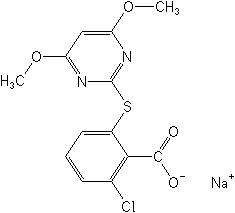-
Common NamePyrithiobac-sodium
-
中文通用名嘧草硫醚
-
IUPACsodium 2-chloro-6-(4,6-dimethoxypyrimidin-2-ylthio)benzoate
-
CASsodium 2-chloro-6-[(4,6-dimethoxy-2-pyrimidinyl)thio]benzoate
-
CAS No.123343-16-8
-
Molecular FormulaC13H10ClN2NaO4S
-
Molecular Structure
-
Category
-
ActivityHerbicide.Pyrithiobac-sodium is primarily a post-emergence herbicide though it can be used from pre- to post-emergence since the compound exhibits residual activity. It is taken up rapidly by roots and shoots and has greatest activity when applied at the 1-3 leaf stage of the weeds. Death occurs 10-14 days after application. Activity is enhanced by the addition of adjuvants such as: non-ionic surfactants; silicon-type adjuvants; and crop oil concentrates. Tank mixes with bromoxynil and/or glyphosate have extended pyrithiobac sodium's weed control spectrum and it is suitable for use on cotton genetically modified to be tolerant to these herbicides. Pyrithiobac has, however, been shown to be antagonistic to some other herbicides in tank mixes. FMC recommends that pyrithiobac-sodium is applied with clomazone pre-emergence, or early post-emergence following clomazone.
When applied post-emergence, pyrithiobac-sodium does not damage the cotton crop at the recommended use rate. Some chlorosis and stunting has been observed, but the quality and yield of cotton is not affected. It is safe to rotational crops. Early-season insecticides can be applied in mixtures or in sequence with pyrithiobac-sodium without crop injury, although some weakening of the cotton fibre has been observed. In field trials, pyrithiobac-sodium gave better control of weeds than commercial standards at lower application rates. -
CropUseCropUses:
cotton
Cotton
35 g ai/ha (pre-emergence)
70 g ai/ha (post-emergence)
-
Physical PropertiesMolecular weight:348.7; Physical form:White solid. Density:1.609; Composition:Tech. is >93%. Melting point:233.8-234.2 °C ( decomp.); Vapour pressure:4.80 × 10-6 mPa (25 °C); Partition coefficient(n-octanol and water):logP = 0.6 ( pH 5), -0.84 ( pH 7); pKa:2.34; Solubility:In water 264 ( pH 5), 705 ( pH 7), 690 ( pH 9), 728 (unbuffered) (all in g/l, 20 °C). In acetone 812, methanol 270 × 103, n-hexane 10, dichloromethane 8.38 (all in mg<; Stability:Stable in water (32 d, pH 5-9, 27 °C) and to heat (15 d at 54 °C).
-
ToxicologyOral:Acute oral LD50 for male rats 3300, female rats 3200 mg/ kg. Percutaneous:Acute percutaneous LD50 for rabbits >2000 mg/kg. Non-irritating to skin; irritating to eyes (rabbits). Inhalation: LC50 (4 h) for rats >6.9 mg/l. Phytotoxicity:Non-phytotoxic to cotton when applied as directed. ADI:( JMPR) 0.1 mg/ kg b.w. [1999].
-
Environmental ProfileEcotoxicology:
Algae: EC50 (5 d) for Selenastrum capricornutum 107µg/l; NOEC for S. capricornutum 22.8mg/l.Bees: LD50 (48 h, contact) >25µg/bee.Birds:Acute oral LD50 for bobwhite quail >2250 mg/ kg b.w. Dietary LC50 (5 d) for mallard ducks and bobwhite quail >5620 mg/ kg50 (48 h) >1100 mg/l.Fish: LC50 (96 h) for bluegill sunfish >930, rainbow trout >1000, sheepshead minnow >145 mg/l.
Environmental fate:
Animals:More than 90% of radiolabelled pyrithiobac, applied orally and intravenously at 5 mg/ kg to rats, was excreted in urine and faeces within 48 h; the major excreted metabolite was the O-desmethyl derivative. PyrithiSoil:Microbial and photochemical degradation play a major role in degradation in the environment; DT50 in silty soil 60 d. Kd 0.32 (sandy loam), 0.60, 0.38, 0.75 (3 silty loam soils).Plant:Amounts of pyrithiobac-sodium in cotton leaves rapidly decreased, following foliar application; at 62 dat, no residues were found; major metabolites found in foliage were the phenol formed by mono-demethylation, and its glucose conjugate. WATER SOLUBILITY: Soluble, 1% wt/wt (pH 5.6)
Fate in soil:
Pyrithiobac-sodium is degraded primarily by soil microbes. It has a soil half-life of approximately 60 days.Fate in aquatic systems:
Pyrithiobac-sodium is degraded photochemically in water. -
Transport InformationSignal Word:WARNING; Hazard Class:II(Moderately hazardous)
Porduct NewsMore
Bayer develops alternative to glyphosate herbicide
Colombia’s Constitutional Court bans chlorpyrifos
ADAMA Canada moves forward with lambda-cyhalothrin sales for 2023
Mexico: Import of glyphosate drops from 16,500 tons to 8,200 tons
Glyphosate prices drop 30% in Argentina
One year extension of EU glyphosate approval failed to pass in the latest meeting
Palmer amaranth in two southern U.S. states now resistant to S-metolachlor
Related CompaniesMore
Country: India
Oxyfluorfen Kasugamycin Carfentrazone-ethyl Bispyribac-sodium Pyrithiobac-sodium Quizalofop-P-ethyl Halosulfuron-methyl Carbendazim+mancozeb Tricyclazole Flusilazole Flusilazole+Carbendazim Iprovalicarb+propineb Propineb Difenoconazole+Propiconazole Isoprothiolane Kasugamycin+copper oxychloride Azoxystrobin+difenoconazole Azoxystrobin+Tebuconazole Propargite Cartap hydrochloride Bifenthrin Carbosulfan Emamectin benzoate Acetamiprid Buprofezin Spinosad Chlorantraniliprole Chlorantraniliprole Spiromesifen Imidacloprid Flubendiamide Cyflumetofen Pyriproxyfen Cartap hydrochloride Pendimethalin Pendimethalin Imazethapyr Clodinafop-propargyl Paraquat dichloride Chlorimuron-ethyl 2,4-D dimethyl amine salt Butachlor Copper oxychloride Carbendazim Copper hydroxide Hexaconazole Kasugamycin Carbendazim+mancozeb Carboxin+thiram Carboxin+thiram Propiconazole Imidacloprid Cartap hydrochloride Cartap hydrochloride Sulfoxaflor Fipronil Lambda-cyhalothrin Lambda-cyhalothrin Quinalphos Phenthoate Chlorpyrifos Dinotefuran Fipronil Fipronil Triazophos Monocrotophos Cypermethrin Cypermethrin Chlorantraniliprole Lambda-cyhalothrin Diafenthiuron Chlorpyrifos+cypermethrin
Shenzhen Baocheng Chemical Industry CO.,LTD.
Country: China
Glyphosate Emamectin benzoate Lambda-cyhalothrin Pyraclostrobin Bromacil Glufosinate-ammonium Tembotrione Prothioconazole Topramezone Chlorantraniliprole
Hangzhou Tianlong Biotechnology Co., Ltd.
Country: China

 0
0 Subscribe
Subscribe
